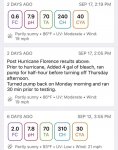What is “transfer equipment”?
I realize some have a whole-house backup generator, but I can’t see us going to such an expense. Most in our area would power on a generator and run a couple extension cords from it into the house, dependent upon what it could handle. Are you stating doing such could harm a lineman when they go to turn power back on?
It all depends on what the folks do with the cords when they get in the house. If you unplug the refrigerator and plug it into a cord, that is fine.
But, if once inside the house you rig something up to plug that cord into a receptacle to "back feed" the whole house system, then yes, you can kill a lineman working down the street.
The best way I have found is to mount a
Generator Power Inlet Box on the side of the house where you will use the generator (stay away from windows that will be open during use due to carbon monoxide poisoning). That inlet box would be wired into the house to either a
Generator Interlock Kit or a full blown
Transfer Switch
If I were you I would find a local electrician to consult with and possibly do the installation. Please don't take this the wrong way, but from your questions you currently don't have the knowledge to do the work safely. Plus, in many jurisdictions this work should be completed by a licensed electrician.
Living in the mountains, power loss can happen on a clear blue day with no storms. I have a
Generac 15000E Generator with a whole house transfer switch. Expensive, but less expensive than an automatic whole house system (which generally requires a natural gas feed which I don't have). I have an LP gas tank, but it would only provide about 1.5 days generator use due to it's small size. I figured it would be better for me to go get gas than to count on the LP Gas company making a delivery every couple of days in a bad storm.


